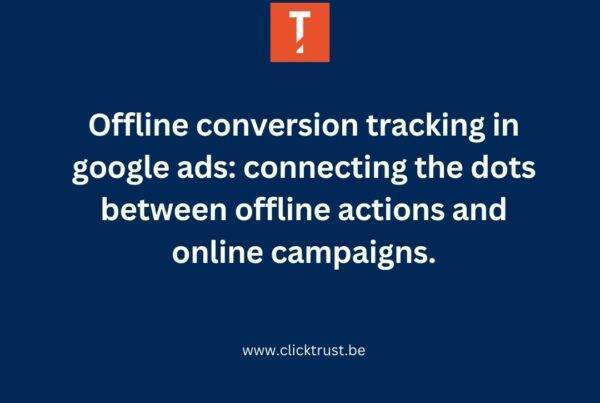For a lot of Google Ads accounts we audit, either as part of a client contract or for a pitch, we notice that a big majority of the total budget is going to Branded traffic. At first sight, the results are also great, driving a majority of the tracked hard conversions at a very low CPL.
Great! Lots of leads, a low cost per lead, let’s continue doing so, right?
While we’ve made these mistakes ourselves in the past, we’ve come to realize this is just inflating the numbers reported by Google Ads, either through Google Ads conversion tags, or even worse, Google Analytics on its default Last-Non-direct-Click attribution model. But is Branded Paid Search really growing the revenue/business of our clients?
The store analogy
Imagine a brick-and-mortar store where at the check-out counter, they’re getting a coupon from a sales rep offering them a 5% reduction on everything they bought.
Of course, every client would be using this coupon. Should the store be giving the sales rep a huge bonus? After all, his coupons seem to be responsible for almost every sale in the store?!
Of course not. The clients were already in the store and had already decided to buy the items in their basket before getting the coupon. The sales rep is actually costing the store 5% of the total sales revenue by giving this reduction.
Navigational traffic?
You could see Branded traffic in the same way, especially for products or services where the customer journey is rather long, and a lot of touchpoints are needed before a sale is made.
By the time someone types in the brand name, they’ve seen a number of ads (TV, Display, Generic Search) and they’ve probably already made their decision to buy on the website. They even remembered the brand name so they can actually search for it. As a result, branded traffic should mainly be seen as navigational traffic, not as a sales “channel”.
Is all branded traffic bad?
So should you blindly turn off all branded campaigns? I’d argue that “it depends”, and you should definitely monitor the results afterward.
If we consider branded searches to be navigational, then, of course, your Organic positions should be great. You have to rank in the first position for your brand name. Worst case scenario, your website isn’t even on the first page in Google’s SERPs. In this case, having Branded Paid Search active can facilitate navigational queries.
Another possibility for having Paid Branded campaigns live is (strong) competition on your brand name in the SERPs. If multiple competitors are buying your brand name in Google Ads, it may be smart to always appear on top of them, again to facilitate the navigational queries by your clients. You won’t pay too much for every click on your ads due to Quality Score, while your competitors will have (much) higher CPCs.
Even with your competitors active on your brand name, you could consider turning off your Branded campaigns. Why would someone go to a competitor’s site if they entered your brand name? This is of course an assumption and would have to be tested. It could also heavily depend on the sector or product.
Another exception could be when you want to sell through your own direct-to-consumer channel instead of through resellers. This is a valid strategy and many brands are doing it (Nike, Dyson, PlayStation, etc.) But, if this is the case, you should have a very good idea of how much branded paid search is worth to you. The revenue reported in Google Analytics coming from Branded Paid Search would still be inflated in terms of business value. The actual value would be the difference in revenue or profit margin if you’re selling on your own website rather than through a reseller. This should be taken into account when evaluating the performance of Branded Search and when assigning budgets to different channels.
To help you decide what to do, we brought everything together in a flowchart:
Are you sure my website won’t lose any traffic?
We took all of the above into consideration and put it to the test on one of our clients. Our hypothesis was that SEO would capture the traffic we’d “lose” by turning off Paid Brand campaigns and that only Generic campaigns brought in incremental traffic.
Important to know:
- Branded SEO positions were very good
- There wasn’t a lot of competition on Branded terms, if any
The baseline for this test was when all campaigns were enabled: Generic and Brand. We then switched off all Google Ads campaigns for two weeks. After those two weeks, we re-enabled Generic campaigns for another two weeks and then switched on Brand again too.
On the screenshot below, you can see the evolution of traffic, with Total sessions, Paid sessions and Organic sessions plotted.

In the first period (Brand & Generic active), we can see that Paid Search brings in about 60% of the total traffic, with Organic bringing in the remaining 40%.
When we switched off all campaigns, we saw that Organic traffic shot up to almost 100% of all traffic generated. The total traffic, however, does seem to have declined slightly.
In the third period, Generic was turned back on. Organic traffic seems stable, but the total traffic has increased slightly with just the amount that Generic seems to be generating. (Period 3 generated 6126 sessions more than Period 2. During Period 3, Generic generated 6357 sessions)
Then, finally, Brand was also turned back on, and the traffic split went back to the original division: Organic took a nosedive to about 40% of the total sessions and Paid sessions picked back up. Total traffic wasn’t affected that much.
We also had a look at the total, cross-channel Leads during these periods. While seasonality is involved in these periods, those numbers also seem to indicate that Paid Branded campaigns don’t bring in any incremental Leads.
Conclusion
Our hypothesis seems to be correct: Brand incrementality is very low at best, and pausing those campaigns should be considered, taking competition in the Google Ads auctions and SEO ranks into account for Branded search terms.
While Branded traffic is cheap on a per-click basis, for big brands, all of those clicks can start to add up to a significant portion of the total budget, and for what?
Would this budget be better spent in Generic Search, getting people to your website who have just shown an intent to purchase the solutions you’re offering? Or if there’s nothing more to be gained in Generic, couldn’t this budget be used to increase brand awareness through Display for example?
Someone who searches for your brand name and purchases on the website after seeing a display ad won’t be attributed to the Display campaigns through click-based attribution models, but thinking Branded search ‘generated’ this search is most likely a very flawed conclusion!
We advise everyone running Branded Paid Search campaigns to re-think this strategy and test if it brings in any incrementality in both traffic and leads!
Recevez notre newsletter &
nos insights
Nous approfondissons les sujets brûlants du marketing numérique et aimons partager.


